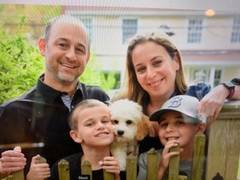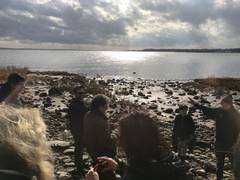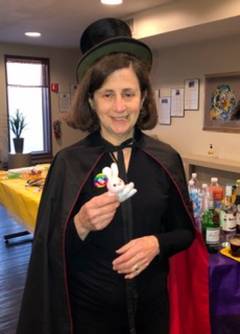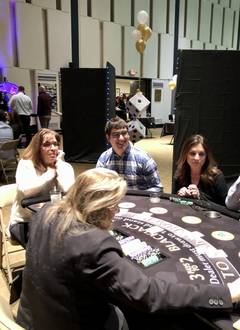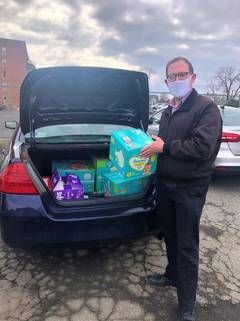Rosh Hashanah 5783 Day 1: Can We Be Together?
10/06/2022 10:57:07 AM
Rabbi Ben Goldberg
| Author | |
| Date Added | |
| Automatically create summary | |
| Summary |
Can we be together?
It was pointed out to me some months ago that this deceptively simple question is in fact the defining question of this moment, for rabbis and Jewish leaders, but really for all of us.
Can we be together?
Allow me to catalog the reasons why being together might not, in fact, be as straightforward as it sounds, or as it used to be.
First of all, COVID–the virus that, two and a half years on, still remains a risk to any kind of gathering or in-person connection. I know there are a range of risk tolerances within our community, with some still minimizing our exposure, while others have accepted this risk, to whatever extent it remains one, and are eager to get on with their normal lives. While all have good reasons for their own approach, this ongoing range of responses are a reason that we might not be able to be together in the most basic sense.
Second: violence, particularly of the antisemitic kind. Less than a year ago, the rabbi and a few congregants at a synagogue not unlike ours were held hostage for hours, barely escaping with their own lives. This was yet the latest reminder of the ongoing and rising threat of antisemitism in the United States. And while Jewish communities are likely at an elevated risk for a violent attack, as schoolchildren in Uvalde, grocery shoppers in Buffalo, and parade spectators in Highland Park, Illinois learned this year, practically any gathering is potentially a target for violent, hateful extremism. We have and will continue to tighten our security procedures, and yet…
Third: political polarization. In recent decades and years, various actors–and if we’re being honest, they exist across the political spectrum, including in the parts where each of us make our homes–have deliberately engaged in polarization as a strategy. News outlets get clicks and eyeballs, and politicians win elections, by presenting the most extreme versions of their point of view, and by portraying their opponents not just as mistaken, but as an existential threat. Our society is increasingly split into two camps that can feel so fundamentally at odds with one another that compromise or even dialogue can feel unachievable. This starts in the national political discourse, but it trickles down, even to a synagogue community.
And finally: the attention economy. To put it bluntly, I sometimes feel like I am competing for your attention with Netflix and Amazon Prime, and they have a lot more money than I do! In all seriousness, we find ourselves in an economic and cultural environment where we can get exactly what we each want, when we each want it. Why bother doing things with others, with all of the compromise and aggravation that sometimes entails, when I can often get exactly what I want right now? What’s more, increasingly demanding and boundary-less jobs leave little time or energy left over for community engagement.
And so: In spite of these and more trends I could list–can we be together?
Today, as we begin this new year, I want to affirm that not only can we be together, but that we must, in spite of the increasing challenges and risks that being together brings.
First, a self-interested reason: being part of a community helps us persevere through whatever life throws at us. The psychologist Dr. Bruce Perry, in a recent book about trauma co-authored with Oprah Winfrey, explains: “For thousands and thousands of years, humans lived in small intergenerational groups. There were no mental health clinics–but there was plenty of trauma.” So how did people make it through?
Dr. Perry explains the four pillars of healing in traditional cultures:
-
Connection to the clan and the natural world
-
Regulating rhythm through dance, drumming, and song
-
Beliefs, values, and stories that brought meaning even to senseless, random trauma
-
And, sometimes, careful use of plant-based substances under the guidance of a healer.
Thinking about Dr. Perry’s list, it strikes me that these are precisely what Judaism, along with many other traditional cultures, can offer us–well, maybe not the hallucinogenic substances. But consider the rest of that list: Jewish community and practice connects us to other people who sustain and support us through the ups and downs of daily life, as well as major moments of rupture, grief, and trauma. Synagogue practice, specifically singing together, can help us stay calm and regulated, along with other rhythmic activities like exercise, breath meditation, coloring and many more. And, perhaps most importantly, Judaism does offer us a broader framework in which to understand our lives, seeing our story as part of the bigger picture that begins with the creation of the world and ends in the Messianic days. I imagine that many of you have experienced this directly: the way that deep roots in Jewish community have helped to steady you in the face of grief, illness and other trials.
Another reason that we need to be together is precisely because of all of those forces that are pulling us apart.There is a danger that Jewish and other faith communities could become just as politically polarized as many other things in our society. We’re at the point that there’s even a strong correlation now between how people vote and where they buy their coffee, let alone what news sources they consult. Synagogues and other faith communities can become places where people choose to come together despite their political and cultural divides, helping everyone develop empathy and understanding, instead of easy stereotypes and simplistic talking points. Community forces us to share time and space with people we wouldn’t otherwise, people of a different generation or sensibility or ideology than our own. It enables us to develop a sense of interdependence, that we all need each other, and that none of us can be Jewish, or human, in isolation.
Finally, being together in community connects us to something larger than ourselves and helps us feel that we matter. I often think about an experience I had just before I started here at KTI. There was a synagogue in Manhattan that I attended frequently. I didn’t think anyone there really knew or cared who I was; and that was fine with me. I was happy just to be an anonymous face in the crowd. One Shabbat just before I started here, I showed up for shul just because, and was offered an aliyah in recognition of our recent marriage and impending move to KTI. I was really touched by this gesture. It turned out that I wasn’t so anonymous after all. Someone knew who I was. Someone cared. Someone reached out.
I think about this experience often, especially now that I am in a position to offer such opportunities to others.What a blessing to have important moments in our lives, and even just our mere existence, seen and validated by others. Such recognition reflects our core belief in the dignity and value of every person, and is an important way we, as a community, can do God’s work on earth.
I could keep naming reasons why community matters. You probably could, too. In some sense, I am preaching to the choir here. Almost by definition, you are all people who have chosen to invest some amount of your time and resources into being part of a community, in some cases, for many years and decades. I don’t need to convince you of the benefits of community.
But, in our increasingly individualistic society that tends to privilege individual self-fulfillment above all else, the kind of deep investment in community I am talking about is counter-cultural. Indeed, last year, for the first time ever, survey data showed that fewer than half of American adults belonged to a religious congregation. Surely there are other important sources of community, but many of them are also much smaller than they were only 20 years ago. The internet era has made it much easier and more plausible to go it alone.
So, as essential yet difficult as community is, there is only so much my or anyone else’s thundering from the pulpit about it can accomplish. Understanding the importance of community is best achieved through experience, not persuasion. If I need to convince you with reasons and evidence that community matters, it’s likely too late.
Instead, we try to demonstrate through experience to children and adults the power of Jewish community. Only through living on Jewish time, together, can people appreciate what it offers and why the investment is worthwhile. For sure, we sometimes fall short of the ideal of community. But that does not stop us from trying to come together, despite everything that is pulling us apart.
With all this in mind, I would like to introduce you to the beautiful new ark doors behind me. We are grateful as a community to everyone involved in the renovation 15 years ago that transformed our sanctuary. And we are deeply appreciative to the family and friends of Bud Freedman, a beloved longtime member and past president of KTI, who so generously donated these new doors that will grace our sanctuary for many years to come in Bud’s memory.
The design of these doors conveys the high value we place on community. This design is inspired by a component of the ancient High Priest’s uniform known as the khoshen or breastplate. That item, as described in the book of Exodus, contained 12 different precious stones, each one corresponding to one of the 12 tribes of Israel. As Aaron and every High Priest after him performed the sacred rituals while wearing this ornament over his heart, he symbolically included the entire Jewish people in that ritual.
That breastplate strikes me as a fitting symbol for community. Each tribe, and really each individual person, is different, bringing different strengths and sensibilities. This is why there were 12 different gems of different colors, instead of 12 identical ones. And yet, in the Temple service, the entire people, despite their differences, were brought together in relationship with the Divine. Different, but together. Unity, without uniformity. Such is the essence of community.
Like other aspects of the Temple service, everything the High Priest wore had to be exactly so. If any of the 12 gemstones were missing, the entire item would become unfit for use. So it is with community: it is incomplete without each one of its members, without each one of you. Each of us is like a facet of a gemstone, coming together to form the lustrous whole.
However, lots of different endeavors can bring people together. What exactly is the purpose of our coming together? In a world where so many opportunities clamor for our time and attention, why a synagogue community?
To answer that, we turn to the inscription above the Ark: L’khavod u’ltifaret: for glory and adornment. These words come from the section of the Torah that describes the High Priest’s attire. There, they suggest that the fancy garments were not meant for the self-aggrandizement of the priest himself, but a reflection of the honor and beauty of God.
Later, these words were incorporated into the last paragraph of the blessing after the haftarah: [sing]: l’khavod ul’tifaret. That prayer offers these two words as part of the purpose of Torah, worship, the Prophets, Shabbat, and holidays, that is, the purpose of Judaism altogether. Kavod: the glory, honor and splendor of the Divine as manifest in human beings and in the world. And tiferet: the beauty and majesty of God’s world around us.
Such is the watchword of ours or any Jewish community: to manifest the Divine Presence in, and increase the beauty of, our corner of the world.
It also helps that tiferet is the T in KTI, making kavod and tiferet fitting guide words for our community in particular.
With this symbolism of community, it is fitting that these doors are dedicated in memory of Bud Freedman. I had the pleasure to know Bud in the last years of his life before his death last fall, and his dedication to the KTI community was deep and sustained. Bud loved people, especially the people of this community. What a wonderful gift that celebrates everything Bud held dear.
And so, with these new additions to our sanctuary as a symbol for everything we hope to accomplish together, we enter into 5783 as a community.
As we enter this year, there is a lot that has and will continue to keep us apart, if we let it. Instead, let us make this a new year of increasing connections within our community. Let’s continue to show up for each other in good times and hard times and plain old ordinary times too. Let us, in the words of the mahzor, “form a single collection to do Your will, O God, with a full heart.” May this year be a year of community, as we each take our place as a shining gem in the beautiful array that brings us together. Ken yehi ratzon, so may it be God’s will, Amen.
Fri, October 17 2025
25 Tishrei 5786
Photo Gallery
Photo Albums
Upcoming Events
-
Tuesday ,
OctOctober 21 , 2025Women's Rosh Chodesh Group
Tuesday, Oct 21st 12:00p to 1:30p
New Women's Rosh Chodesh Group Tuesdays, 12:00-1:30pm Gather with Cantor Sklar and KTI friends at the start of each month of the Hebrew calendar to learn about the themes and traditions of the coming month. Learn from each other, learn more about each other and better understand the women within our tradition. Enjoy music and lunch together! Please a dairy or parve lunch to enjoy at noon, followed by the discussion at 12:30pm. KTI will provide drinks and dessert. RSVP Appreciated -
Wednesday ,
OctOctober 22 , 2025Rabbi, May I? Modern Responsa
Wednesday, Oct 22nd 10:00a to 11:30a
Wednesdays, 10 - 11:30 AM, KTI Library Ever since Abraham’s famous argument with God, Judaism has been full of debate. Moses and Korah, David and Nathan, Hillel and Shammai, the Vilna Gaon and the Ba’al Shem Tov, Spinoza and the Amsterdam Rabbis . . . the list goes on. No wonder that Judaism cherishes the expression machloket l’shem shamayim, “an argument for the sake of heaven.” Beyond their historical importance, what makes these disputations so compelling is that nearly all of them, regardless of their epochs, are still being argued. The parade of characters spanning three millennia of biblical, rabbinic, and modern disputation reflects the panorama of Jewish history with its monumental political, ethical, and spiritual challenges. This series will examine Jewish responses to exile from the biblical period to our modern day. Considering texts from all genres of Jewish literary creativity, we will explore how the realities and iterpretaions Join as we re-open these timeless debates that lead us to the core of 3,000 years of Jewish conversation. • Justice: Abraham vs. God (October 19) • Holiness and Authority: Moses vs. Korah (November 9) • Inclusion: The Five Daughters vs. the Twelve Tribes (November 30) • Accountability and Morality: David vs. Nathan (December 21) • Resistance: Ben Zakkai vs. the Zealots (January 18) • Law: Hillel vs. Shammai (February 15) • Spirituality: The Vilna Gaon vs. the Baal Shem Tov (March 15) • Boundaries: Spinoza vs. the Amsterdam Rabbis (April 19) • Religious Evolution: Geiger vs. Hirsch vs. Frankel (May 10) • Zionism: Herzl vs. Wise (May 31) -
Wednesday ,
OctOctober 22 , 2025Wrestling with God
Wednesday, Oct 22nd 8:00p to 9:30p
Wrestling with God Wednesdays, 8-9:30 PM Congregants’ homes TBA We need to talk about God. And about how we talk, and don’t talk, about God. It’s a big topic, maybe the biggest. This offering invites adult learners into compassionate inquiry, deepening their relationship to Jewish text through collective exploration. Using the album s*ngs ab-ut g?d [https://open.spotify.com/album/6JEY2AN6awAxNfWwmXX460] by Jewish educator Eliana Light as a starting point, this series blends music, Hebrew text study, and open-ended questions to help participants examine their own connections to the divine. This is sacred work. It’s not about getting it right. It’s about showing up with curiosity, humility, and a willingness to join the long lineage of Jews who wrestle with God. Each session stands alone, but we’d love to have a consistent group as much as possible. Dates: September 10: skyman October 22: shadows November 19: in the silence December 10: if only January 21: lead me back February 11: three steps March 11: beyONEd April 29: the mountains May 20: the name June 17: I rise -
Thursday ,
OctOctober 30 , 2025Coffee with the Rabbi
Thursday, Oct 30th 8:00a to 9:00a
Start your morning with some caffeine and casual or meaningful conversation! Join Rabbi Goldberg for a Coffee Chat! Stop by Rye Ridge Starbucks any of the following Thursdays, between 8-9am: June 12 and 26 July 10 and 24 August 7 and 21 September 4 and 18 October 16 and 30 November 6 and 20 December 4 and 18 -
Saturday ,
NovNovember 1 , 2025Dror Israel Shabbat
Shabbat, Nov 1st 11:30a
Dror Israel Shabbat Dror Israel’s Mirit Sulema, along with two leaders of the Arab Youth Movement NOAL, Tal Tunik and Shadi Habiballa, will speak during a Kiddush lunch about their important work with Arab Israeli youth and bringing Jewish, Arab, and Druze youth together. Saturday, November 1st, approx. 11:30am KTI Social Hall "We eat together, laugh together. We talk about what we think of each other, and what will help bring peace.” RSVP Appreciated
Privacy Settings | Privacy Policy | Member Terms
©2025 All rights reserved. Find out more about ShulCloud

